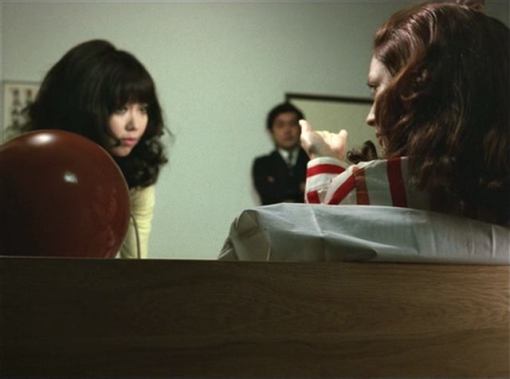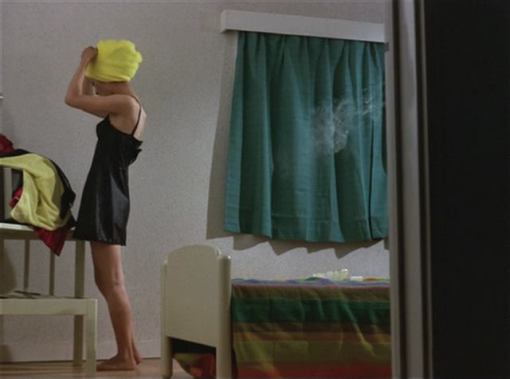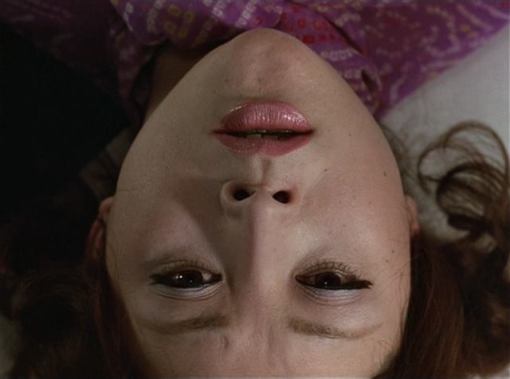If one is to know anything about filmmaker Yuzo Kawashima, it’s that he served as a mentor to the much more celebrated Shohei Imamura. After providing backup for Yasujiro Ozu and Kinuyo Tanaka, Kawashima was the last director Imamura took orders from. Unlike Ozu and Tanaka, there isn’t as much written about Kawashima so the impulse is to engage through his work and its connection with Imamura. This isn’t a completely useless exercise, but it does limit us. Perhaps it is most helpful to begin with what Kawashima and screenwriter Toshiro Ide (a frequent Naruse collaborator) manage to do here. Maybe it won’t strike us especially original and new on the surface, but their conversation that comes from it is unique.
Tsutae and Yoshiji are an unemployed couple pondering their fate on the center of the bridge. They’re reached a literal and figurative crossroads, all options for a “normal” life seem to have been exhausted. Tsutae schmoozes her way into a job as a barmaid at an establishment run by an old acquaintance, Otuku. Yoshiji isn’t entirely accepting of his girlfriend’s role, in particular its proximity to sex work. He doesn’t entirely know Tsutae’s past, but he knows he doesn’t want her “falling back” into those old ways. Otuku manages to get Yoshiji a job as a noodle deliveryman, where he is befriended by a Tamako, a gentle woman that seems eager to get close to him. All this happens while Otuku’s runaway husband returns with the intention of resuming his role as a father.
I can imagine a certain type of cynical viewer watching the opening fifteen minutes of this film and rolling their eyes at the prospect of yet another Japanese film from the 1950s dealing with some variation of sex work. 1956 alone also gave us Naruse’s Flowing and Mizoguchi’s Street of Shame. The irony, of course, is that in 1956, Japan’s anti-prostitution laws were looming. As always, it feels necessary to distinguish between forms of sex work in Japan, the women here are closer to Mizoguchi’s “prostitutes” – a word that I hesitate using just because of the violence it inflicts on its targets, but they occupy a different place in society as the geishas in Naruse’s Flowing. The geishas, at least in a superficial way, are more “respectable” even as they are subjected to just as much ill will from men.
Tsutae in Suzaki Paradise Red Light doesn’t occupy either position, though the space she occupies is marked with the more scrutinized prostitutes of Mizoguchi’s film. Although the viewer never sees her doing anything beyond pouring drinks, her place of business, because it is in Suzaki, is marked as being lower. It’s this marking that bothers Yoshiji, because neither he nor us learns about Tsutae’s past, we are teased about it, invited to imagine a existence in which she did have to sell her body to make money. He sees himself (and men in general) as being necessary for women in order to protect them from such a life, yet Tsutae becomes a barmaid because Yoshiji’s ideas for making money has left them with absolutely nothing. He sees this as failing his patriarchal duty. He bundles up this frustration, which leads to his obsessive outbursts that threaten to ruin their relationship entirely.
The films ends with the two’s reconciliation. Just like the beginning, they stand on a bridge and wonder how they’ll make a life together. Tsutae, sensing the frustration she’s caused her boyfriend, tells him that he gets to pick where they go next. It’s easy to read this ending as a confirmation of the same patriarchal values that Yoshiji fails to live up to, but I hesitate to accept this. I think the reality is instead that Tsutae, perhaps out of convenience, has stayed in this relationship. She does so because it is slightly more pleasant than the life she saw working as a barmaid, even as it did provide her with some financial comfort. Maybe she’s terrified of change, and thus, she accepts a familiar reality, the one which was introduced to us in the beginning of the film. The opacity of her decision benefits the film, maybe it lacks “logic” yet it seems more grounded to reality. It’s sad and unfortunate for Tsutae, but who are we to question her choice?









